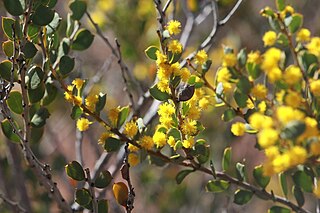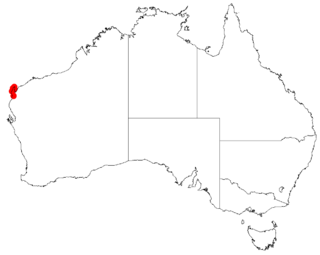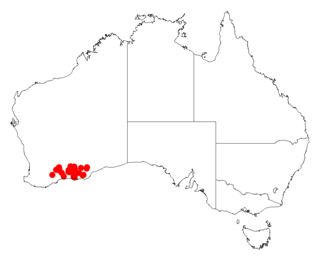
Acacia bifaria is a shrub belonging to the genus Acacia. It is native to an area along the south coast of Western Australia.

Acacia acanthaster is a species of flowering plant in the family Fabaceae and is endemic to the south-west of Western Australia. It is a rigid, densely-branched, domed shrub with flat, linear phyllodes, spherical heads of golden-yellow flowers, and curved pods that resemble a string of beads.

Acacia acoma is a species of flowering plant in the family Fabaceae and is endemic to inland ares of south-western Western Australia. It is an erect, spindly, open or spreading shrub with variably-shaped, often narrowly oblong phyllodes, flowers arranged in spherical heads, usually arranged in pairs in leaf axils, and strongly curved or spirally coiled pods up to 15 mm (0.59 in) long when expanded.

Acacia alexandri is a shrub belonging to the genus Acacia and the subgenus Phyllodineae native to north western Australia.

Acacia argutifolia, commonly known as the East Barrens wattle, is a shrub belonging to the genus Acacia and the subgenus Phyllodineae.
Acacia blaxellii, also known as Blaxell's wattle, is a shrub belonging to the genus Acacia and the subgenus Phyllodineae endemic to Western Australia.

Acacia chartacea is a shrub or tree belonging to the genus Acacia and the subgenus Phyllodineae endemic to an area along the west coast of Western Australia.

Acacia concolorans is a shrub belonging to the genus Acacia and the subgenus Phyllodineae that is endemic to Western Australia.

Acacia evenulosa is a shrub belonging to the genus Acacia and the subgenus Phyllodineae native to Western Australia.

Acacia excentrica is a shrub belonging to the genus Acacia and the subgenus Phyllodineae native to Western Australia.

Acacia heterochroa is a shrub belonging to the genus Acacia and the subgenus Phyllodineae that is endemic to south western Australia.

Acacia hystrix is a shrub belonging to the genus Acacia and the subgenus Phyllodineae that is endemic to south western Australia.

Acacia lanceolata is a shrub belonging to the genus Acacia and the subgenus Phyllodineae and is endemic to a small area of western Australia.

Acacia lullfitziorum is a shrub belonging to the genus Acacia and the subgenus Phyllodineae that is endemic to south west Australia
Acacia minutissima is a shrub belonging to the genus Acacia and the subgenus Phyllodineae that is endemic to parts of western Australia.
Acacia muriculata, commonly known as Koolanooka wattle, is a shrub belonging to the genus Acacia and the subgenus Phyllodineae that is endemic to a small area of south western Australia.

Acacia mutabilis is a shrub belonging to the genus Acacia and the subgenus Phyllodineae that is endemic to south western Australia.

Acacia ryaniana is a shrub of the genus Acacia and the subgenus Phyllodineae that is endemic to an area along the west coast of Australia.

Acacia simulans is a shrub of the genus Acacia and the subgenus Phyllodineae that is endemic to south western Australia.
Acacia anserina, also known as hairy sandstone wattle, is a shrub of the genus Acacia and the subgenus Plurinerves. It is native to a small area in the Kimberley region of Western Australia.
















